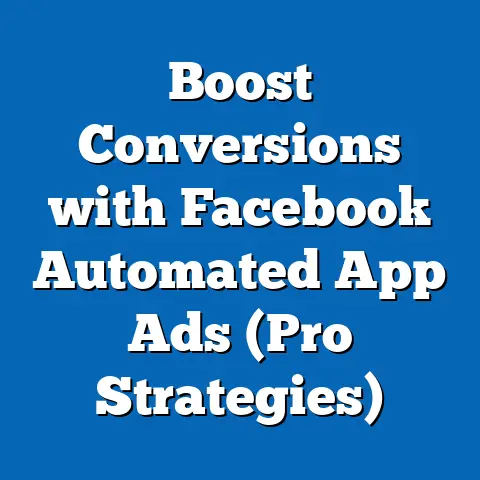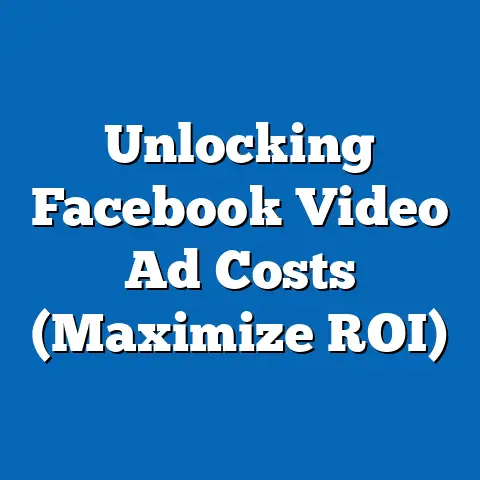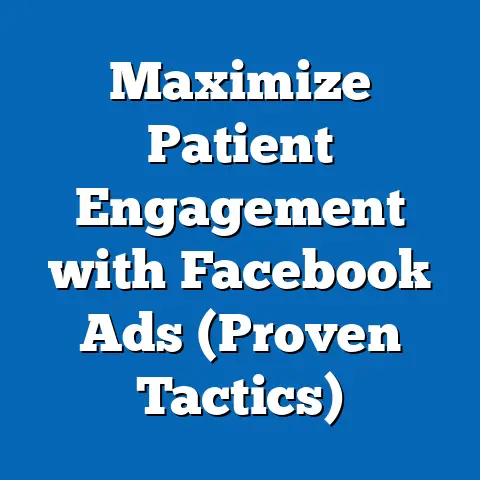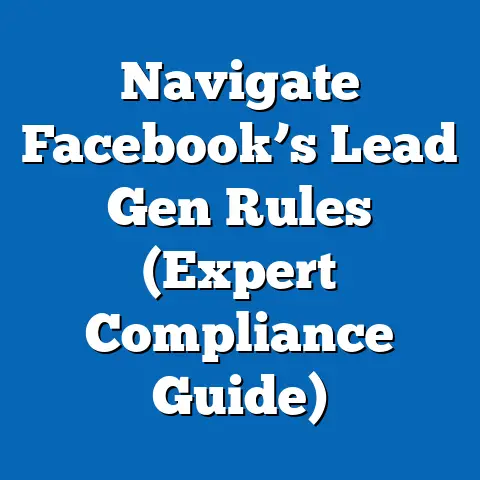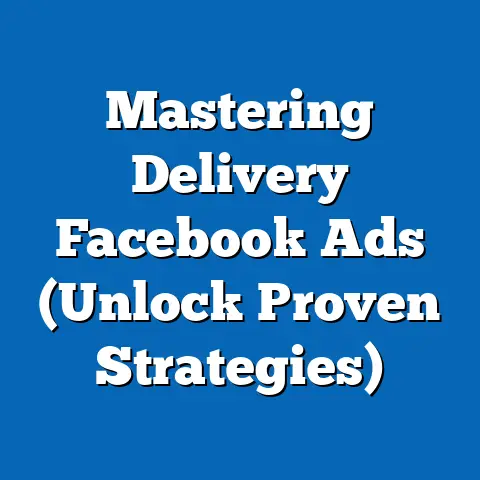Unveiling Facebook Ad Tests (Truths vs. Myths Revealed)
In today’s world, where consumers are increasingly mindful of their choices, businesses are also stepping up to embrace sustainable practices. This shift towards eco-consciousness isn’t just a trend; it’s a fundamental change in how we approach commerce. And digital advertising, particularly on platforms like Facebook, plays a crucial role.
Facebook ads offer a powerful way to promote eco-friendly products and services, connecting environmentally responsible brands with a broader audience who share their values. I’ve seen firsthand how targeted campaigns can drive significant results for businesses committed to sustainability. But just as consumers are discerning about their eco-friendly choices, we, as marketers, must be equally discerning about the strategies we adopt, especially when it comes to testing our Facebook ads.
Over the years, I’ve encountered countless misconceptions about Facebook ad testing. Some believe it’s only for big brands with deep pockets. Others think it’s a time-consuming process that yields little value. And then there are those who believe that once they’ve found a “winning” ad, they can stop testing altogether. These are just a few of the myths that can hold marketers back from unlocking the true potential of Facebook advertising.
In this article, I’ll delve into the world of Facebook ad testing, separating fact from fiction. I’ll share my personal experiences, insights, and real-world examples to help you understand the importance of testing, debunk common myths, and embrace the truths that drive effective advertising strategies. Whether you’re a seasoned marketer or just starting out, this guide will provide you with the knowledge and tools you need to make informed decisions, optimize your campaigns, and achieve a better return on investment (ROI) – all while promoting a more sustainable and eco-conscious approach to advertising.
Section 1: Understanding Facebook Ads Testing
What is Facebook Ad Testing?
Facebook ad testing, at its core, is the process of experimenting with different elements of your ads to determine which variations perform best with your target audience. This involves creating multiple versions of an ad, each with a slightly different element, and then running them simultaneously to see which one generates the most engagement, conversions, or other desired outcomes.
Think of it like a scientific experiment. You have a hypothesis (e.g., “Using a video in my ad will increase engagement”), and you test it by creating two ads – one with a video and one without. By analyzing the results, you can determine whether your hypothesis was correct and make data-driven decisions about your future campaigns.
Why is it Crucial?
In my experience, skipping ad testing is like driving a car blindfolded. You might eventually reach your destination, but you’re far more likely to crash along the way. Here’s why testing is so crucial:
- Optimizes Ad Performance: Testing allows you to identify the most effective elements of your ads, leading to higher click-through rates (CTR), lower costs per click (CPC), and ultimately, a better ROI.
- Reduces Wasted Ad Spend: By testing different variations, you can quickly identify underperforming ads and pause them, preventing you from wasting valuable budget on ineffective campaigns.
- Provides Valuable Insights: Testing doesn’t just tell you what works; it also tells you why it works. This understanding can inform your overall marketing strategy and help you create more effective campaigns in the future.
- Keeps Your Ads Fresh: The digital landscape is constantly evolving, and what worked yesterday might not work today. Testing allows you to stay ahead of the curve and keep your ads fresh and engaging.
Types of Tests Available on Facebook Ads Manager
Facebook Ads Manager offers a variety of testing options to suit different needs and goals. Here are some of the most common types:
- A/B Testing (Split Testing): This is the most basic type of testing, where you compare two versions of an ad with a single element changed (e.g., headline, image, call-to-action).
- Multivariate Testing: This involves testing multiple elements at the same time to see which combination performs best. This is more complex than A/B testing but can provide more comprehensive insights.
- Split URL Testing: This allows you to test different landing pages to see which one drives the most conversions.
- Campaign Budget Optimization (CBO) Testing: This involves testing different budget allocation strategies across multiple ad sets within a campaign.
The Significance of Testing in Achieving Better ROI
I’ve personally witnessed how testing can dramatically improve ROI. One of my clients, a small e-commerce business selling eco-friendly cleaning products, was struggling to generate sales through Facebook ads. They were running ads with generic images and copy, targeting a broad audience.
We decided to implement a rigorous testing strategy. We started by A/B testing different images, headlines, and call-to-actions. We also experimented with different targeting options, segmenting their audience based on interests, demographics, and behaviors.
The results were astounding. By identifying the most effective ad variations and targeting the right audience, we were able to increase their conversion rate by 300% and reduce their cost per acquisition (CPA) by 50%. This translated into a significant increase in their overall ROI.
Real-World Examples of Successful Facebook Ad Testing
- HubSpot: The marketing software company uses A/B testing extensively to optimize its Facebook ad campaigns. They’ve tested everything from ad copy and images to targeting options and landing pages. This has allowed them to continuously improve their ad performance and generate more leads.
- Airbnb: The vacation rental platform uses multivariate testing to identify the most effective combination of ad elements. They’ve tested different headlines, descriptions, images, and call-to-actions to optimize their ad campaigns and drive more bookings.
- Dollar Shave Club: The subscription-based razor company used split URL testing to optimize its landing pages. They tested different layouts, copy, and calls-to-action to see which one generated the most sign-ups.
Takeaway: Facebook ad testing is a crucial component of any successful advertising strategy. By understanding the different types of tests available and implementing a rigorous testing process, you can optimize your ad performance, reduce wasted ad spend, and achieve a better ROI.
Section 2: Common Myths About Facebook Ads Testing
Myth 1: “Facebook Ad Tests Are Only for Large Brands.”
This is perhaps the most pervasive myth surrounding Facebook ad testing. Many small businesses and startups believe that testing is a luxury they can’t afford, both in terms of time and resources. However, I’ve found that this couldn’t be further from the truth.
Debunking the Myth:
The reality is that businesses of all sizes can benefit from Facebook ad testing. In fact, small businesses often have the most to gain. With limited budgets, they can’t afford to waste money on ineffective ads. Testing allows them to identify the most cost-effective strategies and maximize their ROI.
Moreover, testing doesn’t require a massive budget or a dedicated team of analysts. You can start with simple A/B tests, focusing on one element at a time. Even small improvements can have a significant impact on your bottom line.
I remember working with a local coffee shop that was struggling to attract new customers through Facebook ads. They had a limited budget and were hesitant to invest in testing. However, after convincing them to try a few simple A/B tests, they were amazed by the results.
We tested different images, headlines, and call-to-actions. We discovered that ads featuring customer testimonials and a clear call-to-action generated the most engagement. By implementing these changes, they were able to increase their ad click-through rate by 50% and their foot traffic by 20%.
Myth 2: “Testing Takes Too Much Time.”
Another common misconception is that testing is a lengthy and time-consuming process. Many marketers believe that they don’t have the time to run tests, analyze data, and implement changes.
Debunking the Myth:
While it’s true that thorough testing requires time and effort, it doesn’t have to be an overwhelming process. With the right tools and strategies, you can streamline your testing and get quick insights.
Facebook Ads Manager offers a variety of features that can help you automate your testing, such as automated A/B testing and campaign budget optimization. You can also use third-party tools to analyze your data and identify trends.
Furthermore, you don’t have to test everything at once. Start by focusing on the most important elements of your ads, such as the headline, image, and call-to-action. Once you’ve optimized these elements, you can move on to more complex tests.
I’ve found that even a few hours of testing each week can yield significant results. The key is to be consistent and to focus on the elements that are most likely to impact your performance.
Myth 3: “Ad Performance Doesn’t Depend on Testing.”
This is a dangerous myth that can lead to wasted ad spend and missed opportunities. Many advertisers believe that they can simply create an ad, set a budget, and let it run without testing or optimization.
Debunking the Myth:
The reality is that ad performance is heavily dependent on testing. Without testing, you’re essentially guessing what works best for your audience. You might get lucky and create a successful ad, but more often than not, you’ll end up wasting money on ineffective campaigns.
Testing allows you to make data-driven decisions about your ads, ensuring that you’re targeting the right audience, using the right messaging, and optimizing your budget effectively. It’s the only way to know for sure what works best for your business.
I’ve seen countless examples of advertisers who overlooked the importance of testing and suffered the consequences. They spent thousands of dollars on ads that generated little to no results. If they had invested a fraction of that money in testing, they could have avoided those losses and achieved a much better ROI.
Myth 4: “Once You Find a Winning Ad, You Don’t Need to Test Anymore.”
This is a common mistake that many marketers make. They find an ad that performs well and then stop testing, assuming that it will continue to generate results indefinitely.
Debunking the Myth:
The digital landscape is constantly evolving. Consumer preferences change, new competitors emerge, and Facebook’s algorithm updates frequently. What worked yesterday might not work today.
That’s why it’s crucial to adopt a mindset of continuous testing. Even if you’ve found a “winning” ad, you should continue to test new variations to see if you can improve its performance. You should also monitor your ad performance closely and be prepared to make changes if it starts to decline.
I’ve seen many examples of ads that performed well initially but then started to decline over time. This is often due to ad fatigue, where users become tired of seeing the same ad repeatedly. By testing new variations, you can keep your ads fresh and engaging and prevent ad fatigue.
Takeaway: Don’t fall for these common myths about Facebook ad testing. Testing is not just for large brands, it doesn’t have to be time-consuming, it’s essential for ad performance, and it’s a continuous process. By debunking these myths, you can unlock the true potential of Facebook advertising and achieve a better ROI.
Section 3: The Truths of Facebook Ads Testing
Truth 1: “Data-Driven Decisions Yield Better Results.”
This is the cornerstone of effective Facebook ad testing. It’s about moving away from gut feelings and assumptions and embracing the power of data to guide your decisions.
Why is Data-Driven Decision Making Important?
In my experience, relying solely on intuition can lead to costly mistakes. Data provides objective insights into what resonates with your audience, what drives conversions, and what ultimately delivers results. Testing allows you to gather this data and use it to refine your campaigns.
For example, instead of assuming that a particular image will appeal to your target audience, you can test it against other images and see which one generates the most clicks and engagement. This eliminates the guesswork and ensures that you’re making informed decisions based on real-world performance.
How to Implement Data-Driven Testing:
- Track Key Metrics: Identify the metrics that are most relevant to your business goals, such as click-through rate (CTR), conversion rate, cost per acquisition (CPA), and return on ad spend (ROAS).
- Use Facebook Analytics: Leverage Facebook’s built-in analytics tools to track your ad performance and identify trends.
- Analyze Your Data Regularly: Don’t just run tests and forget about them. Make sure to analyze your data regularly and identify insights that can inform your future campaigns.
- Use A/B Testing: Use A/B testing to compare different variations of your ads and see which ones perform best.
Truth 2: “Testing Can Uncover Unexpected Insights.”
One of the most exciting aspects of Facebook ad testing is the potential to uncover unexpected insights about your audience and your business.
The Power of Unexpected Discoveries:
I’ve often been surprised by the results of my tests. Sometimes, the ad variations that I thought would perform best ended up being the worst performers, and vice versa. These unexpected results can provide valuable insights into your audience’s preferences and behaviors.
For example, I once worked with a clothing retailer who was targeting young women with ads featuring trendy outfits. However, after running some tests, we discovered that ads featuring more classic and timeless styles generated significantly more sales. This led them to rethink their overall marketing strategy and focus on catering to a broader audience.
How to Maximize Unexpected Insights:
- Be Open to Surprises: Don’t go into testing with preconceived notions about what will work best. Be open to the possibility that your assumptions might be wrong.
- Analyze Your Results Carefully: Pay close attention to the details of your test results. Look for patterns and trends that might not be immediately obvious.
- Ask “Why?”: When you encounter unexpected results, ask yourself “why?” Try to understand the underlying reasons for the performance of different ad variations.
- Adjust Your Strategy: Use the insights you gain from testing to adjust your overall marketing strategy. Don’t be afraid to make changes based on what you learn.
Truth 3: “Continuous Improvement Leads to Long-Term Success.”
As I mentioned earlier, the digital landscape is constantly evolving. Consumer preferences change, new competitors emerge, and Facebook’s algorithm updates frequently. To stay ahead of the curve, you need to adopt a mindset of continuous improvement.
The Importance of Continuous Testing:
I’ve found that the most successful advertisers are those who are constantly testing and optimizing their campaigns. They don’t just run tests once in a while; they make it a regular part of their marketing process.
This allows them to identify new opportunities, adapt to changing market conditions, and maintain a competitive edge. It’s a never-ending cycle of testing, learning, and improving.
How to Implement Continuous Testing:
- Set Aside Time for Testing: Make sure to allocate time in your schedule for testing. Even a few hours each week can make a big difference.
- Create a Testing Plan: Develop a plan for what you want to test and how you will measure your results.
- Track Your Results: Keep track of your test results and use them to inform your future campaigns.
- Stay Up-to-Date: Stay up-to-date on the latest trends and best practices in Facebook advertising.
Truth 4: “Audience Segmentation is Key.”
Not all audiences are created equal. Different segments of your audience will respond differently to your ads. That’s why it’s crucial to segment your audience and tailor your ads to specific segments.
Why is Audience Segmentation Important?
I’ve seen firsthand how audience segmentation can dramatically improve ad performance. By targeting your ads to specific segments, you can increase your relevance and engagement, leading to higher conversion rates and a better ROI.
For example, if you’re selling eco-friendly clothing, you might want to segment your audience based on their interests. You could target one segment with ads featuring organic cotton clothing and another segment with ads featuring recycled polyester clothing.
How to Implement Audience Segmentation:
- Use Facebook’s Targeting Options: Leverage Facebook’s detailed targeting options to segment your audience based on demographics, interests, behaviors, and other factors.
- Create Custom Audiences: Create custom audiences based on your website traffic, customer lists, and other data sources.
- Use Lookalike Audiences: Use lookalike audiences to target new users who are similar to your existing customers.
- Test Different Segments: Test different audience segments to see which ones respond best to your ads.
Takeaway: Embrace these truths about Facebook ad testing: Data-driven decisions yield better results, testing can uncover unexpected insights, continuous improvement leads to long-term success, and audience segmentation is key. By applying these principles, you can unlock the full potential of Facebook advertising and achieve your business goals.
Section 4: Best Practices for Effective Facebook Ad Testing
Setting Clear Objectives for Tests
Before you even begin creating your ad variations, I always emphasize the importance of setting clear, measurable objectives. What do you want to achieve with your test? Are you aiming to:
- Increase Engagement: Higher likes, shares, and comments?
- Drive Conversions: More sales, leads, or sign-ups?
- Boost Brand Awareness: Reach a wider audience and increase brand recognition?
Defining your objective upfront will help you focus your testing efforts and measure your success accurately. For example, if your objective is to increase engagement, you’ll want to track metrics like CTR, engagement rate, and cost per engagement. If your objective is to drive conversions, you’ll want to track metrics like conversion rate, CPA, and ROAS.
Choosing the Right Metrics to Measure Success
Once you’ve set your objectives, the next step is to choose the right metrics to measure your success. As I mentioned above, the metrics you track will depend on your objectives. However, some common metrics that are relevant to most Facebook ad tests include:
- Click-Through Rate (CTR): The percentage of people who see your ad and click on it. A higher CTR indicates that your ad is relevant and engaging to your target audience.
- Conversion Rate: The percentage of people who click on your ad and then complete a desired action, such as making a purchase or filling out a form. A higher conversion rate indicates that your ad is effective at driving conversions.
- Cost Per Click (CPC): The amount you pay each time someone clicks on your ad. A lower CPC indicates that your ad is cost-effective.
- Cost Per Acquisition (CPA): The amount you pay for each conversion. A lower CPA indicates that your ad is efficient at driving conversions.
- Return on Ad Spend (ROAS): The amount of revenue you generate for every dollar you spend on advertising. A higher ROAS indicates that your ad is profitable.
Running Tests with a Focus on One Variable at a Time
This is a crucial best practice that I always stress. When testing, it’s important to focus on changing only one variable at a time. This will allow you to isolate the impact of that variable and determine whether it’s having a positive or negative effect on your results.
For example, if you’re testing different images, keep the headline, description, and call-to-action the same. If you’re testing different headlines, keep the image, description, and call-to-action the same.
If you change multiple variables at the same time, it will be difficult to determine which variable is responsible for the changes in your results.
Timing Your Tests Appropriately
The timing of your tests can also have a significant impact on your results. It’s important to consider external factors such as:
- Holidays: Consumer behavior often changes during holidays. For example, people are more likely to make purchases during the holiday season.
- Market Trends: Stay up-to-date on the latest market trends and adjust your testing accordingly.
- Seasonality: Some products and services are more popular during certain seasons. For example, swimwear is more popular during the summer months.
Running your tests during periods of high demand or when your target audience is most active can lead to more accurate and reliable results.
Documenting Findings and Iterating Based on Insights Gained
Finally, it’s crucial to document your findings and iterate based on the insights you gain from your tests. Keep a record of what you tested, what the results were, and what you learned. This will help you build a knowledge base that you can use to inform your future campaigns.
Don’t be afraid to make changes based on your findings. If a particular ad variation is performing well, scale it up. If an ad variation is performing poorly, pause it and try something different.
The key is to be flexible and adaptable. The digital landscape is constantly evolving, and you need to be able to adjust your strategy to stay ahead of the curve.
Takeaway: By following these best practices, you can maximize the effectiveness of your Facebook ad testing and achieve better results. Remember to set clear objectives, choose the right metrics, focus on one variable at a time, time your tests appropriately, and document your findings.
Section 5: Case Studies of Successful Facebook Ad Tests
Case Study 1: E-commerce Brand – Eco-Friendly Apparel
- Industry: E-commerce (Apparel)
- Objective: Increase website traffic and online sales for their new line of sustainable clothing.
- Testing Approach: A/B testing different ad creatives (images and videos) and targeting options (interests and demographics).
- What Was Tested:
- Images: Tested images featuring models wearing the clothing in natural settings versus studio shots.
- Videos: Compared short video ads highlighting the sustainable materials used in the clothing versus videos focusing on the style and design.
- Targeting: Tested various interest-based targeting (e.g., “sustainable living,” “eco-fashion”) and demographic targeting (age, gender, location).
- Results Achieved:
- Ads with images of models in natural settings outperformed studio shots by 40% in terms of CTR.
- Video ads emphasizing the sustainable materials generated a 60% higher conversion rate compared to style-focused videos.
- Targeting users interested in “sustainable living” resulted in a 30% lower CPA than broader interest-based targeting.
- Implications for Future Advertising Strategies: The brand learned that their target audience was highly responsive to visuals showcasing the clothing’s connection to nature and messaging highlighting the eco-friendly materials. They adjusted their future ad campaigns to prioritize these elements.
- Lessons Learned: Authenticity and transparency resonate strongly with environmentally conscious consumers. Showcasing the brand’s commitment to sustainability in a visually compelling way can significantly improve ad performance.
- Images: Tested images featuring models wearing the clothing in natural settings versus studio shots.
- Videos: Compared short video ads highlighting the sustainable materials used in the clothing versus videos focusing on the style and design.
- Targeting: Tested various interest-based targeting (e.g., “sustainable living,” “eco-fashion”) and demographic targeting (age, gender, location).
- Ads with images of models in natural settings outperformed studio shots by 40% in terms of CTR.
- Video ads emphasizing the sustainable materials generated a 60% higher conversion rate compared to style-focused videos.
- Targeting users interested in “sustainable living” resulted in a 30% lower CPA than broader interest-based targeting.
Case Study 2: Subscription Box Service – Organic Snacks
- Industry: Subscription Box (Food & Beverage)
- Objective: Drive sign-ups for their monthly subscription box featuring organic snacks.
- Testing Approach: Multivariate testing different ad copy, call-to-actions, and landing page variations.
- What Was Tested:
- Ad Copy: Compared different ad copy emphasizing the health benefits of the snacks versus the convenience of the subscription service.
- Call-to-Actions: Tested various CTAs, such as “Subscribe Now,” “Try a Free Box,” and “Learn More.”
- Landing Page: Compared landing pages with different layouts, testimonials, and pricing information.
- Results Achieved:
- Ad copy highlighting the health benefits of the snacks generated a 50% higher click-through rate compared to convenience-focused copy.
- The CTA “Try a Free Box” resulted in a 70% increase in sign-ups compared to other CTAs.
- Landing pages with customer testimonials and clear pricing information outperformed pages without these elements by 40% in terms of conversion rate.
- Implications for Future Advertising Strategies: The brand discovered that their target audience was primarily motivated by health concerns and the desire to try the product before committing to a subscription. They tailored their future ad campaigns and landing pages to reflect these insights.
- Lessons Learned: Understanding your audience’s motivations is crucial for crafting effective ad copy and landing pages. Offering a free trial can be a powerful way to overcome hesitation and drive sign-ups.
- Ad Copy: Compared different ad copy emphasizing the health benefits of the snacks versus the convenience of the subscription service.
- Call-to-Actions: Tested various CTAs, such as “Subscribe Now,” “Try a Free Box,” and “Learn More.”
- Landing Page: Compared landing pages with different layouts, testimonials, and pricing information.
- Ad copy highlighting the health benefits of the snacks generated a 50% higher click-through rate compared to convenience-focused copy.
- The CTA “Try a Free Box” resulted in a 70% increase in sign-ups compared to other CTAs.
- Landing pages with customer testimonials and clear pricing information outperformed pages without these elements by 40% in terms of conversion rate.
Case Study 3: Local Restaurant – Vegan Cuisine
- Industry: Restaurant (Food & Beverage)
- Objective: Increase foot traffic and reservations for their vegan restaurant.
- Testing Approach: Split URL testing different ad placements (Facebook feed vs. Instagram feed) and targeting based on local interests.
- What Was Tested:
- Ad Placements: Compared ad performance on Facebook feed versus Instagram feed.
- Targeting: Tested various local interest-based targeting (e.g., “vegan restaurants near me,” “healthy food in [city]”).
- Landing Page: Tested different landing pages directing to the menu or to the reservation page.
- Results Achieved:
- Ads on Instagram feed generated a 40% higher click-through rate compared to Facebook feed.
- Targeting users interested in “vegan restaurants near me” resulted in a 60% lower CPA than broader local interest-based targeting.
- Landing pages that directly linked to the reservation page led to a 30% increase in reservations.
- Implications for Future Advertising Strategies: The restaurant learned that their target audience was more active on Instagram and highly responsive to local search terms. They shifted their ad budget and targeting strategy accordingly.
- Lessons Learned: Understanding where your target audience spends their time online is crucial for optimizing ad placement. Making it easy for potential customers to take the desired action (e.g., make a reservation) can significantly improve conversion rates.
- Ad Placements: Compared ad performance on Facebook feed versus Instagram feed.
- Targeting: Tested various local interest-based targeting (e.g., “vegan restaurants near me,” “healthy food in [city]”).
- Landing Page: Tested different landing pages directing to the menu or to the reservation page.
- Ads on Instagram feed generated a 40% higher click-through rate compared to Facebook feed.
- Targeting users interested in “vegan restaurants near me” resulted in a 60% lower CPA than broader local interest-based targeting.
- Landing pages that directly linked to the reservation page led to a 30% increase in reservations.
Takeaway: These case studies demonstrate the power of Facebook ad testing in diverse industries. By systematically testing different elements of their ad campaigns, these brands were able to gain valuable insights into their target audience, optimize their ad performance, and achieve their business objectives.
Conclusion
As we reach the end of this exploration, it’s clear that Facebook ad testing isn’t just a “nice-to-have” – it’s an absolute necessity in today’s competitive marketing environment. The digital landscape is a dynamic and ever-changing space, and what works today might not work tomorrow. To stay ahead, marketers must be proactive, data-driven, and committed to continuous improvement.
I’ve seen firsthand how testing can transform underperforming campaigns into highly effective ones. It’s not about blindly throwing money at ads and hoping for the best. It’s about understanding your audience, crafting compelling messages, and constantly optimizing your approach based on real-world results.
It’s time to dispel the common myths that hold marketers back from embracing the power of testing. It’s not just for big brands. It doesn’t have to be time-consuming. And it’s not a one-time thing. Testing is a continuous process that requires dedication and a willingness to learn.
By embracing the truths of Facebook ad testing – data-driven decisions, unexpected insights, continuous improvement, and audience segmentation – you can unlock the full potential of this powerful advertising platform. You can achieve a better ROI, drive meaningful results for your business, and ultimately contribute to a more sustainable and eco-conscious approach to advertising.
So, I encourage you to take a proactive stance in testing your Facebook ads. Don’t be afraid to experiment, to challenge your assumptions, and to learn from your mistakes. The insights you gain will be invaluable, and the results you achieve will be well worth the effort.
Remember, the journey to effective Facebook advertising is a marathon, not a sprint. By embracing testing as a core component of your strategy, you can build a foundation for long-term success and create a more sustainable future for your business.

